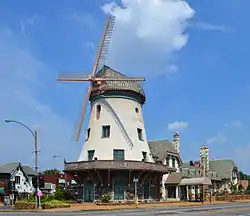Bevo Mill, St. Louis
Bevo Mill is a neighborhood located in south St. Louis, Missouri.
Bevo Mill | |
|---|---|
 Bevo Mill, the namesake of the neighborhood | |
 Location (red) of Bevo Mill within St. Louis | |
| Country | United States |
| State | Missouri |
| City | St. Louis |
| Wards | 13, 14 |
| Area | |
| • Total | 1.37 sq mi (3.5 km2) |
| Population (2010)[1] | |
| • Total | 12,654 |
| • Density | 9,200/sq mi (3,600/km2) |
| ZIP Code | Part of 63116 |
| Area code | 314 |
Populace
The Bevo Mill area is directly to the west of the neighborhood of Dutchtown, which was a major center of German settlement in St. Louis in the mid-nineteenth century. After significant population loss in the later twentieth century, the neighborhood was revitalized in the 1990s by immigrants fleeing the devastating war in Bosnia and Croatia. Today, much of the Bevo Mill neighborhood is populated with immigrants, particularly Bosnian Americans and Croatian Americans. The St. Louis metro area is now home to an estimated 70,000 Bosnians, the largest population per capita outside Europe.[2][3] The influx of new immigrants has helped stem the decline in St. Louis's population.[4] Many Bosnians have bought homes in South St. Louis and started new businesses, including bakeries, cafés, taverns, nightclubs, restaurants, neighborhood grocery stores and butcher shops, stimulating the economy[5] and transforming the area, once known for crime, into a safe, thriving neighborhood.[6]
Bevo Mill
The neighborhood was named after the Bevo Mill, a distinctive restaurant with a windmill and beer hall at Gravois and Morganford roads. The restaurant was opened by August Busch Sr. in 1917.[7] It operated under the name Bevo Mill until its closure in 2009.[8] In 2017, a restaurant and event venue named Das Bevo opened at the location. The restaurant closed in 2019 and the venue remains in operation.[9]
Demographics
In 2010, Bevo Mill's racial makeup was 74.2% White, 13.8% Black, 0.4% Native American, 4.6% Asian, 3.9% Two or More Races, and 3.1% Some Other Race. 7.5% of Bevo Mill's population was of Hispanic or Latino origin.[10]
See also
- Holly Hills, St. Louis, southeast of Bevo
- History of Bosnian Americans in St. Louis
References
- Census Summary By Neighborhoods Archived September 2, 2009, at the Wayback Machine
- http://www.theatlanticcities.com/politics/2013/02/why-are-there-so-many-bosnians-st-louis/4668/
- Preston, Julia (15 April 2010). "Work Force Fueled by Highly Skilled Immigrants". New York Times. Retrieved September 30, 2011.
- Preston, Julia (15 April 2010). "Work Force Fueled by Highly Skilled Immigrants". New York Times. Retrieved September 30, 2011.
- Tucci, Linda (11 April 1999). "Refugees Revitalizing City Neighborhoods". St. Louis Business Journal. Retrieved September 30, 2011.
- "How Muslim refugees from Bosnia transformed a corner of the Midwest". The Economist. 19 December 2015. Retrieved 22 December 2015.
- http://www.losttables.com/bevo/bevo.htm
- "Bevo Mill closes".
- https://www.riverfronttimes.com/foodblog/2019/02/07/das-bevo-closes-its-kitchen-planning-a-new-future-as-event-host
- "Archived copy". Archived from the original on 2012-05-16. Retrieved 2012-08-13.CS1 maint: archived copy as title (link)
External links
- Bevo Mill Neighborhood on stlouis-mo.gov